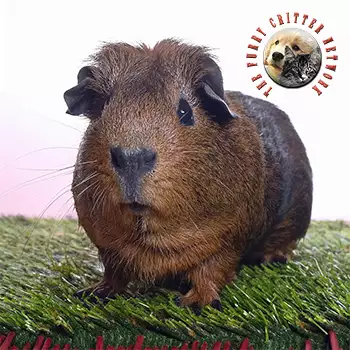Breed Standard
- The Agouti is a dark-eyed ticked cavy in which the ticking covers the whole of the body other than the belly.
- In judging Agoutis, the emphasis must be on quality of ticking, color, type and condition. Exhibits should not be unduly penalised for minor faults if they possess these qualities.
- Size is very desirable, but not at the expense of cobbyness or quality.
- Grooming is essential to producing an even effect on the body and sides of the cavy.
- Chest faults are often accompanied by poor color and, if this is the case, should be severely penalised.
- Exhibits should not be penalised for wide belly unless the belly colour is visible when viewed from the side.
- Dark or unticked feet, although these are faults, are preferable to light or uneven feet.
- In U/5 exhibits a small degree of eye circles or some unevenness on feet should not be unduly penalised, as these faults may clear as the cavy matures.
Behavior
Guinea pigs can learn complex paths to food, and can accurately remember a learned path for months. Their strongest problem solving strategy is motion. While guinea pigs can jump small obstacles, they are poor climbers, and are not particularly agile. They startle extremely easily, and will either freeze in place for long periods or run or cover with rapid, darting motions when they sense danger. Larger groups of startled guinea pigs will "stampede", running in haphazard directions as a means of confusing predators. When excited, guinea pigs may repeatedly perform little hops in the air (known as "popcorning"). They are also exceedingly good swimmers.
Summary
If handled correctly early in their life, guinea pigs become amenable to being picked up and carried, and seldom bite or scratch. They are timid explorers and often hesitate to attempt an escape from their cage even when an opportunity presents itself. Still, they show considerable curiosity when allowed to walk freely, especially in familiar and safe terrain. Guinea pigs that become familiar with their owner will whistle on the owner's approach; they will also learn to whistle in response to the rustling of plastic bags or the opening of refrigerator doors, where their food is most commonly stored.
Guinea pigs should be kept in pairs or, preferably groups, unless there is a specific medical condition that requires isolation. Lone guinea pigs are more likely to suffer from stress and depression. Domesticated guinea pigs come in many breeds, which have been developed since their introduction to Europe and North America. These varieties vary in hair and color composition. The most common varieties found in pet stores are the English shorthair (also known as the American), which have a short, smooth coat, and the Abyssinian, whose coat is ruffled with cowlicks, or rosettes. Also popular among breeders are the Peruvian and the Sheltie (or Silkie), both straight longhair breeds, and the Texel, a curly longhair.
Cavy Clubs and Associations dedicated to the showing and breeding of guinea pigs have been established worldwide. The American Cavy Breeders Association, an adjunct to the American Rabbit Breeders' Association, is the governing body in the United States and Canada. The British Cavy Council governs cavy clubs in the United Kingdom. Similar organizations exist in Australia (Australian National Cavy Council) and New Zealand (New Zealand Cavy Club). Each club publishes its own Standard of Perfection and determines which breeds are eligible for showing.






